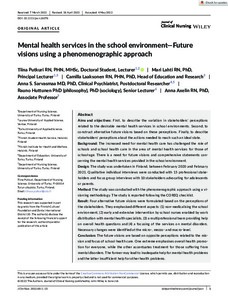Mental health services in the school environment—Future visions using a phenomenographic approach
Putkuri Tiina; Lahti Mari; Laaksonen Camilla; Sarvasmaa Anna S.; Huttunen Rauno; Axelin Anna
https://urn.fi/URN:NBN:fi-fe2022081154271
Tiivistelmä
Aims and objectives: First, to describe the variation in stakeholders' perceptions related to the desirable mental health services in school environments. Second, to construct alternative future visions based on these perceptions. Finally, to describe stakeholders' perceptions about the actions needed to reach such an ideal state.
Background: The increased need for mental health care has challenged the role of schools and school health care in the area of mental health services for those of school-age. There is a need for future visions and comprehensive statements concerning the mental health services provided in the school environment.
Design: The study was undertaken in Finland, between February 2020 and February 2021. Qualitative individual interviews were conducted with 15 professional stakeholders and focus group interviews with 10 stakeholders advocating for adolescents or parents.
Method: The study was conducted with the phenomenographic approach using a visioning methodology. The study is reported following the COREQ checklist.
Result: Four alternative future visions were formulated based on the perceptions of the stakeholders. They emphasised different aspects: (1) non-medicalising the school environment, (2) early and extensive intervention by school nurses enabled by work distribution with mental health specialists, (3) a multiprofessional team providing help on overall health questions and (4) a focusing of the services on mental disorders. Necessary changes were identified at the micro-, mezzo- and macro-level.
Conclusion: The future visions are based on opposite perceptions related to the mission and focus of school health care. One extreme emphasises overall health promotion for everyone, while the other accentuates treatment for those suffering from mental disorders. The former may lead to inadequate help for mental health problems and the latter insufficient help for other health problems.
Relevance to clinical practice: This study contributes alternative future visions, promotes strategic planning and helps to clarify the future role of school nurses.
Kokoelmat
- Rinnakkaistallenteet [27094]
